Industrial Building Systems (IBS) in Malaysia: An Overview
VerifiedAdded on 2020/05/28
|9
|3890
|340
Report
AI Summary
This report provides a comprehensive overview of Industrial Building Systems (IBS) in Malaysia. It begins with a preface defining IBS and its significance in the construction sector, emphasizing its role in enhancing productivity and quality through prefabrication and off-site manufacturing. The report then delves into the core concepts of IBS, including definitions from CIDB Malaysia and other sources, highlighting the prefabrication and mass production processes. It discusses the classification of IBS, including precast systems, steel formwork systems, and composite construction processes, further categorizing the latter into steel, timber, and block systems. The report also details the advantages of adopting IBS, such as cleaner construction sites, environmental sustainability, cost reduction through labor and material savings, and labor force reduction. Finally, it addresses the disadvantages and challenges faced by Malaysian contractors in adapting to IBS, offering a balanced perspective on its implementation.
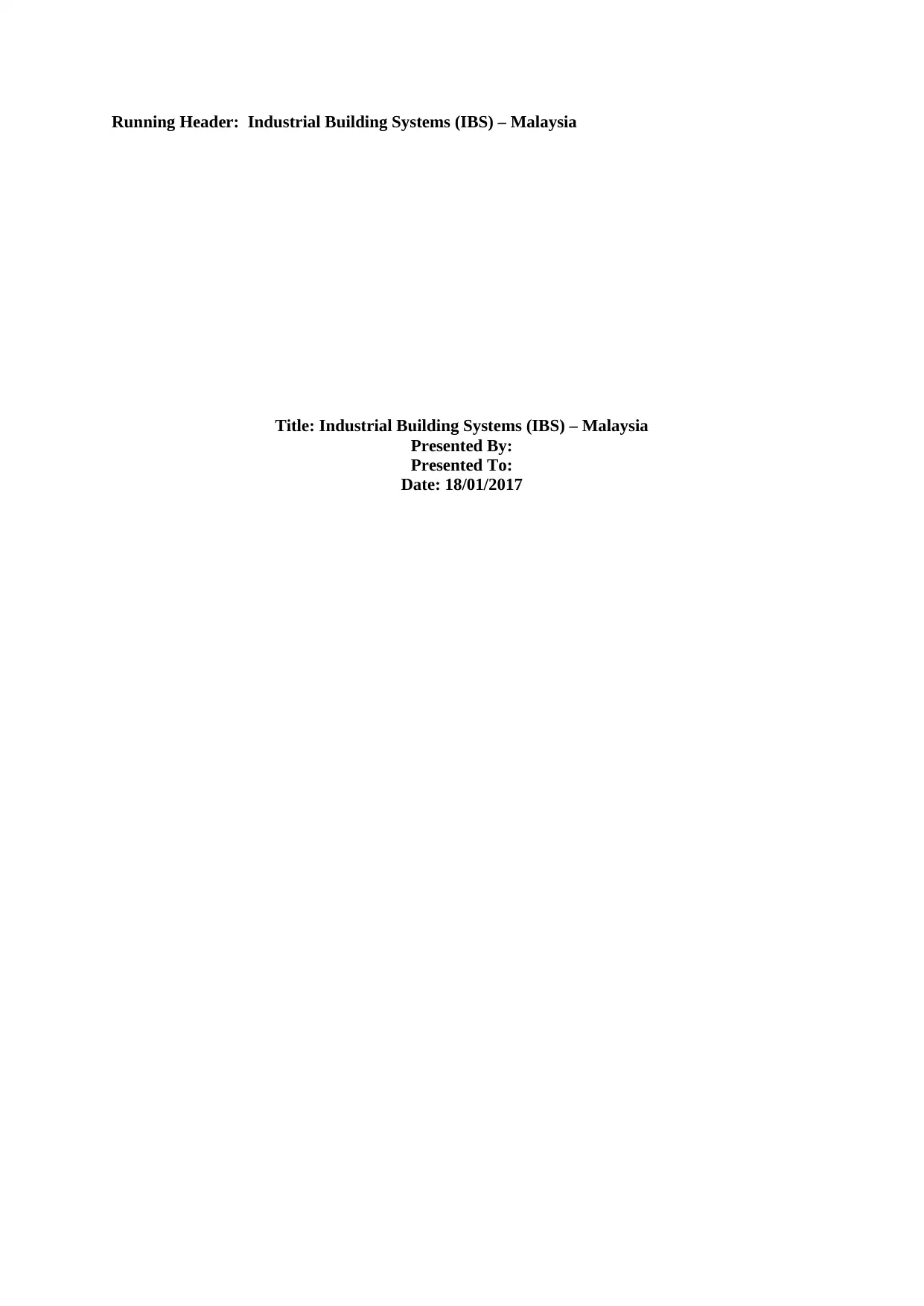
Running Header: Industrial Building Systems (IBS) – Malaysia
Title: Industrial Building Systems (IBS) – Malaysia
Presented By:
Presented To:
Date: 18/01/2017
Title: Industrial Building Systems (IBS) – Malaysia
Presented By:
Presented To:
Date: 18/01/2017
Paraphrase This Document
Need a fresh take? Get an instant paraphrase of this document with our AI Paraphraser
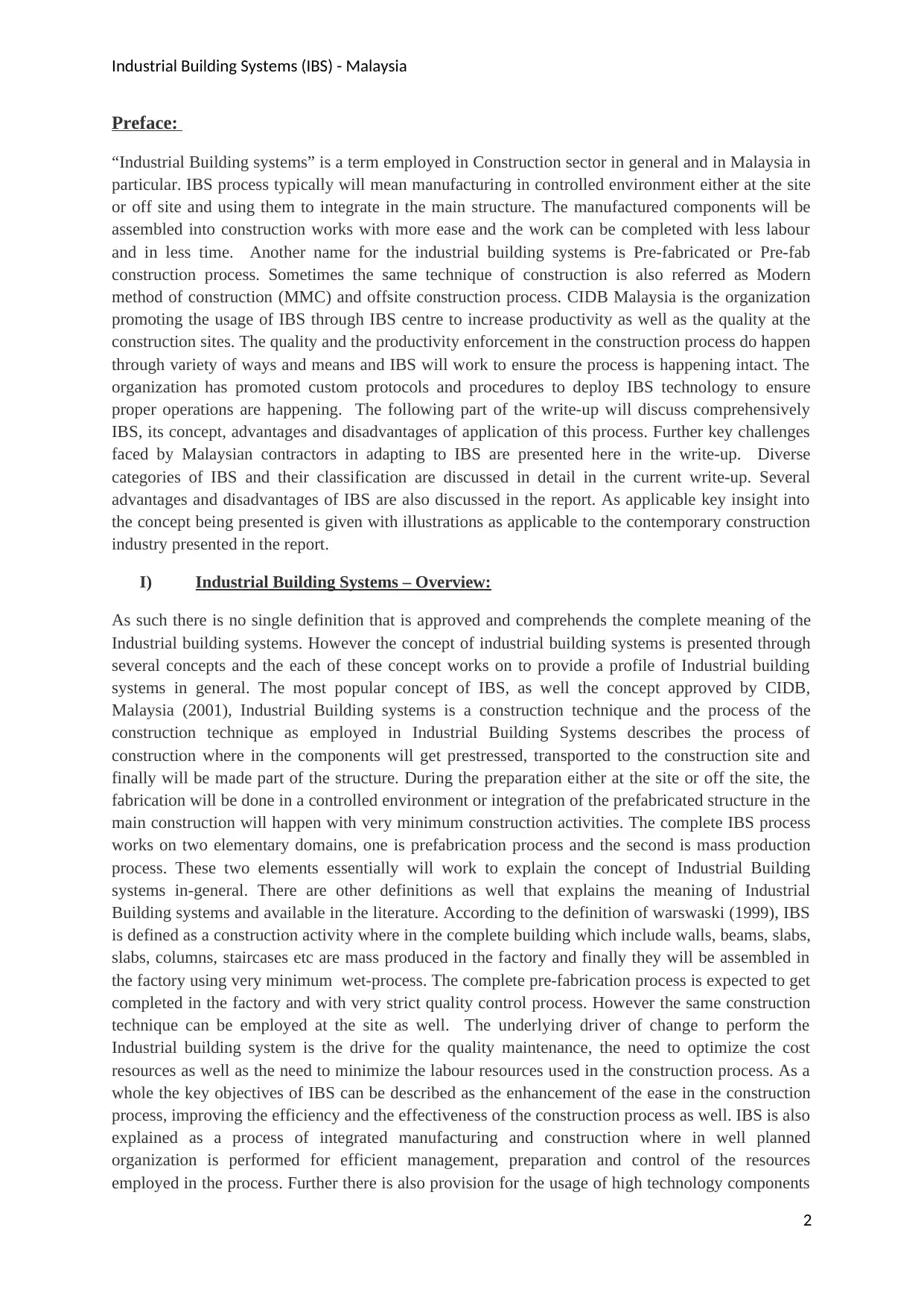
Industrial Building Systems (IBS) - Malaysia
Preface:
“Industrial Building systems” is a term employed in Construction sector in general and in Malaysia in
particular. IBS process typically will mean manufacturing in controlled environment either at the site
or off site and using them to integrate in the main structure. The manufactured components will be
assembled into construction works with more ease and the work can be completed with less labour
and in less time. Another name for the industrial building systems is Pre-fabricated or Pre-fab
construction process. Sometimes the same technique of construction is also referred as Modern
method of construction (MMC) and offsite construction process. CIDB Malaysia is the organization
promoting the usage of IBS through IBS centre to increase productivity as well as the quality at the
construction sites. The quality and the productivity enforcement in the construction process do happen
through variety of ways and means and IBS will work to ensure the process is happening intact. The
organization has promoted custom protocols and procedures to deploy IBS technology to ensure
proper operations are happening. The following part of the write-up will discuss comprehensively
IBS, its concept, advantages and disadvantages of application of this process. Further key challenges
faced by Malaysian contractors in adapting to IBS are presented here in the write-up. Diverse
categories of IBS and their classification are discussed in detail in the current write-up. Several
advantages and disadvantages of IBS are also discussed in the report. As applicable key insight into
the concept being presented is given with illustrations as applicable to the contemporary construction
industry presented in the report.
I) Industrial Building Systems – Overview:
As such there is no single definition that is approved and comprehends the complete meaning of the
Industrial building systems. However the concept of industrial building systems is presented through
several concepts and the each of these concept works on to provide a profile of Industrial building
systems in general. The most popular concept of IBS, as well the concept approved by CIDB,
Malaysia (2001), Industrial Building systems is a construction technique and the process of the
construction technique as employed in Industrial Building Systems describes the process of
construction where in the components will get prestressed, transported to the construction site and
finally will be made part of the structure. During the preparation either at the site or off the site, the
fabrication will be done in a controlled environment or integration of the prefabricated structure in the
main construction will happen with very minimum construction activities. The complete IBS process
works on two elementary domains, one is prefabrication process and the second is mass production
process. These two elements essentially will work to explain the concept of Industrial Building
systems in-general. There are other definitions as well that explains the meaning of Industrial
Building systems and available in the literature. According to the definition of warswaski (1999), IBS
is defined as a construction activity where in the complete building which include walls, beams, slabs,
slabs, columns, staircases etc are mass produced in the factory and finally they will be assembled in
the factory using very minimum wet-process. The complete pre-fabrication process is expected to get
completed in the factory and with very strict quality control process. However the same construction
technique can be employed at the site as well. The underlying driver of change to perform the
Industrial building system is the drive for the quality maintenance, the need to optimize the cost
resources as well as the need to minimize the labour resources used in the construction process. As a
whole the key objectives of IBS can be described as the enhancement of the ease in the construction
process, improving the efficiency and the effectiveness of the construction process as well. IBS is also
explained as a process of integrated manufacturing and construction where in well planned
organization is performed for efficient management, preparation and control of the resources
employed in the process. Further there is also provision for the usage of high technology components
2
Preface:
“Industrial Building systems” is a term employed in Construction sector in general and in Malaysia in
particular. IBS process typically will mean manufacturing in controlled environment either at the site
or off site and using them to integrate in the main structure. The manufactured components will be
assembled into construction works with more ease and the work can be completed with less labour
and in less time. Another name for the industrial building systems is Pre-fabricated or Pre-fab
construction process. Sometimes the same technique of construction is also referred as Modern
method of construction (MMC) and offsite construction process. CIDB Malaysia is the organization
promoting the usage of IBS through IBS centre to increase productivity as well as the quality at the
construction sites. The quality and the productivity enforcement in the construction process do happen
through variety of ways and means and IBS will work to ensure the process is happening intact. The
organization has promoted custom protocols and procedures to deploy IBS technology to ensure
proper operations are happening. The following part of the write-up will discuss comprehensively
IBS, its concept, advantages and disadvantages of application of this process. Further key challenges
faced by Malaysian contractors in adapting to IBS are presented here in the write-up. Diverse
categories of IBS and their classification are discussed in detail in the current write-up. Several
advantages and disadvantages of IBS are also discussed in the report. As applicable key insight into
the concept being presented is given with illustrations as applicable to the contemporary construction
industry presented in the report.
I) Industrial Building Systems – Overview:
As such there is no single definition that is approved and comprehends the complete meaning of the
Industrial building systems. However the concept of industrial building systems is presented through
several concepts and the each of these concept works on to provide a profile of Industrial building
systems in general. The most popular concept of IBS, as well the concept approved by CIDB,
Malaysia (2001), Industrial Building systems is a construction technique and the process of the
construction technique as employed in Industrial Building Systems describes the process of
construction where in the components will get prestressed, transported to the construction site and
finally will be made part of the structure. During the preparation either at the site or off the site, the
fabrication will be done in a controlled environment or integration of the prefabricated structure in the
main construction will happen with very minimum construction activities. The complete IBS process
works on two elementary domains, one is prefabrication process and the second is mass production
process. These two elements essentially will work to explain the concept of Industrial Building
systems in-general. There are other definitions as well that explains the meaning of Industrial
Building systems and available in the literature. According to the definition of warswaski (1999), IBS
is defined as a construction activity where in the complete building which include walls, beams, slabs,
slabs, columns, staircases etc are mass produced in the factory and finally they will be assembled in
the factory using very minimum wet-process. The complete pre-fabrication process is expected to get
completed in the factory and with very strict quality control process. However the same construction
technique can be employed at the site as well. The underlying driver of change to perform the
Industrial building system is the drive for the quality maintenance, the need to optimize the cost
resources as well as the need to minimize the labour resources used in the construction process. As a
whole the key objectives of IBS can be described as the enhancement of the ease in the construction
process, improving the efficiency and the effectiveness of the construction process as well. IBS is also
explained as a process of integrated manufacturing and construction where in well planned
organization is performed for efficient management, preparation and control of the resources
employed in the process. Further there is also provision for the usage of high technology components
2
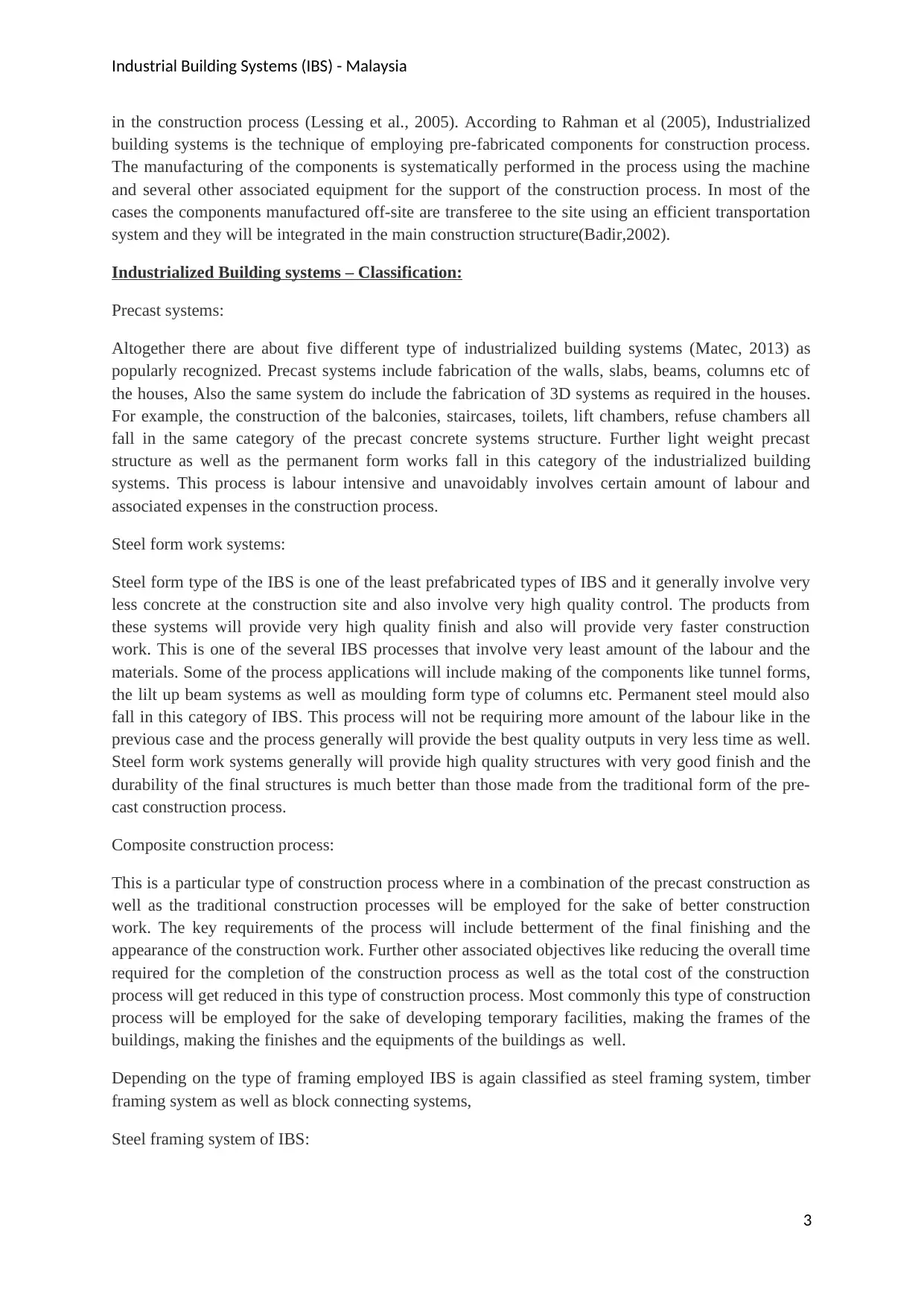
Industrial Building Systems (IBS) - Malaysia
in the construction process (Lessing et al., 2005). According to Rahman et al (2005), Industrialized
building systems is the technique of employing pre-fabricated components for construction process.
The manufacturing of the components is systematically performed in the process using the machine
and several other associated equipment for the support of the construction process. In most of the
cases the components manufactured off-site are transferee to the site using an efficient transportation
system and they will be integrated in the main construction structure(Badir,2002).
Industrialized Building systems – Classification:
Precast systems:
Altogether there are about five different type of industrialized building systems (Matec, 2013) as
popularly recognized. Precast systems include fabrication of the walls, slabs, beams, columns etc of
the houses, Also the same system do include the fabrication of 3D systems as required in the houses.
For example, the construction of the balconies, staircases, toilets, lift chambers, refuse chambers all
fall in the same category of the precast concrete systems structure. Further light weight precast
structure as well as the permanent form works fall in this category of the industrialized building
systems. This process is labour intensive and unavoidably involves certain amount of labour and
associated expenses in the construction process.
Steel form work systems:
Steel form type of the IBS is one of the least prefabricated types of IBS and it generally involve very
less concrete at the construction site and also involve very high quality control. The products from
these systems will provide very high quality finish and also will provide very faster construction
work. This is one of the several IBS processes that involve very least amount of the labour and the
materials. Some of the process applications will include making of the components like tunnel forms,
the lilt up beam systems as well as moulding form type of columns etc. Permanent steel mould also
fall in this category of IBS. This process will not be requiring more amount of the labour like in the
previous case and the process generally will provide the best quality outputs in very less time as well.
Steel form work systems generally will provide high quality structures with very good finish and the
durability of the final structures is much better than those made from the traditional form of the pre-
cast construction process.
Composite construction process:
This is a particular type of construction process where in a combination of the precast construction as
well as the traditional construction processes will be employed for the sake of better construction
work. The key requirements of the process will include betterment of the final finishing and the
appearance of the construction work. Further other associated objectives like reducing the overall time
required for the completion of the construction process as well as the total cost of the construction
process will get reduced in this type of construction process. Most commonly this type of construction
process will be employed for the sake of developing temporary facilities, making the frames of the
buildings, making the finishes and the equipments of the buildings as well.
Depending on the type of framing employed IBS is again classified as steel framing system, timber
framing system as well as block connecting systems,
Steel framing system of IBS:
3
in the construction process (Lessing et al., 2005). According to Rahman et al (2005), Industrialized
building systems is the technique of employing pre-fabricated components for construction process.
The manufacturing of the components is systematically performed in the process using the machine
and several other associated equipment for the support of the construction process. In most of the
cases the components manufactured off-site are transferee to the site using an efficient transportation
system and they will be integrated in the main construction structure(Badir,2002).
Industrialized Building systems – Classification:
Precast systems:
Altogether there are about five different type of industrialized building systems (Matec, 2013) as
popularly recognized. Precast systems include fabrication of the walls, slabs, beams, columns etc of
the houses, Also the same system do include the fabrication of 3D systems as required in the houses.
For example, the construction of the balconies, staircases, toilets, lift chambers, refuse chambers all
fall in the same category of the precast concrete systems structure. Further light weight precast
structure as well as the permanent form works fall in this category of the industrialized building
systems. This process is labour intensive and unavoidably involves certain amount of labour and
associated expenses in the construction process.
Steel form work systems:
Steel form type of the IBS is one of the least prefabricated types of IBS and it generally involve very
less concrete at the construction site and also involve very high quality control. The products from
these systems will provide very high quality finish and also will provide very faster construction
work. This is one of the several IBS processes that involve very least amount of the labour and the
materials. Some of the process applications will include making of the components like tunnel forms,
the lilt up beam systems as well as moulding form type of columns etc. Permanent steel mould also
fall in this category of IBS. This process will not be requiring more amount of the labour like in the
previous case and the process generally will provide the best quality outputs in very less time as well.
Steel form work systems generally will provide high quality structures with very good finish and the
durability of the final structures is much better than those made from the traditional form of the pre-
cast construction process.
Composite construction process:
This is a particular type of construction process where in a combination of the precast construction as
well as the traditional construction processes will be employed for the sake of better construction
work. The key requirements of the process will include betterment of the final finishing and the
appearance of the construction work. Further other associated objectives like reducing the overall time
required for the completion of the construction process as well as the total cost of the construction
process will get reduced in this type of construction process. Most commonly this type of construction
process will be employed for the sake of developing temporary facilities, making the frames of the
buildings, making the finishes and the equipments of the buildings as well.
Depending on the type of framing employed IBS is again classified as steel framing system, timber
framing system as well as block connecting systems,
Steel framing system of IBS:
3
⊘ This is a preview!⊘
Do you want full access?
Subscribe today to unlock all pages.

Trusted by 1+ million students worldwide
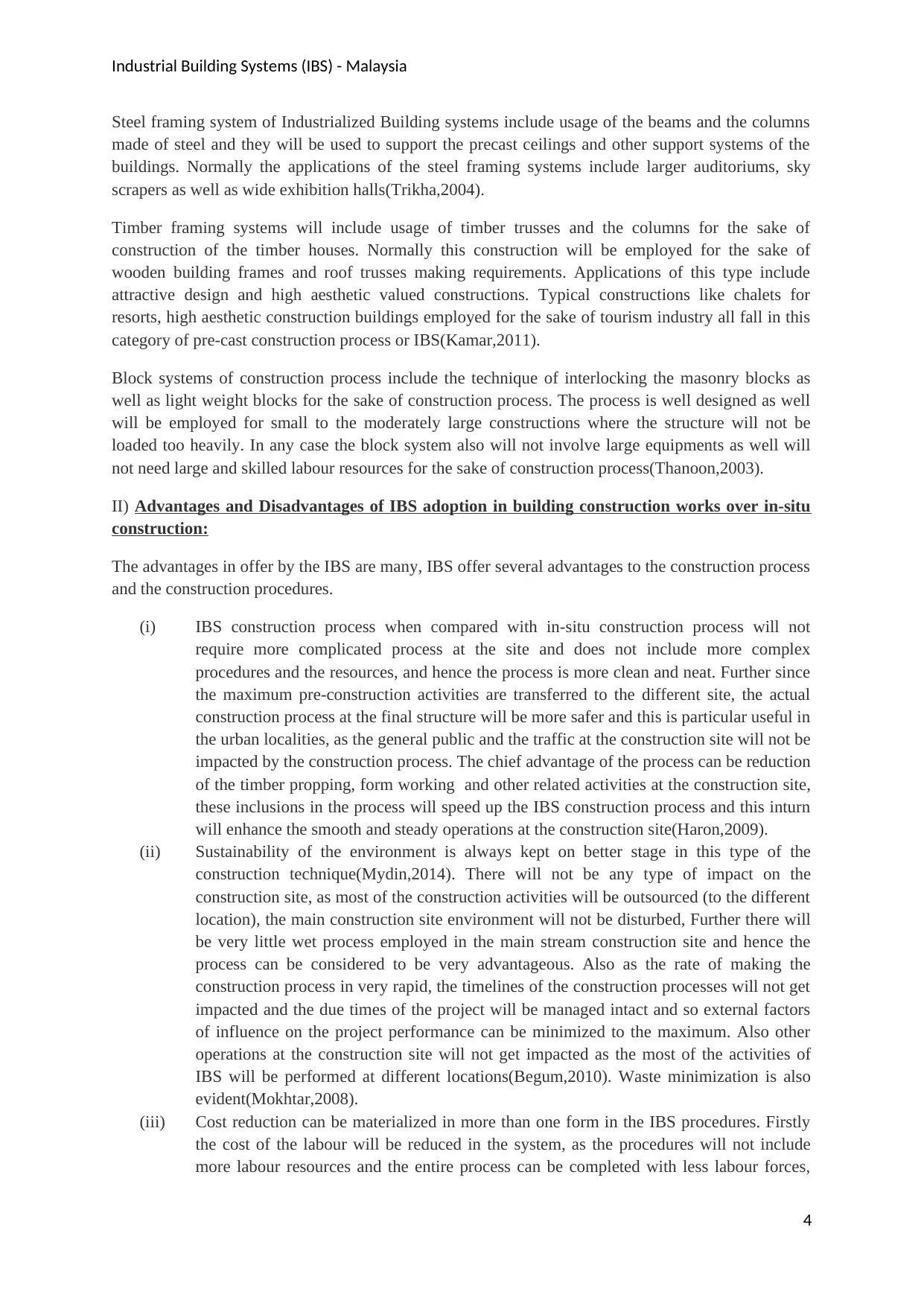
Industrial Building Systems (IBS) - Malaysia
Steel framing system of Industrialized Building systems include usage of the beams and the columns
made of steel and they will be used to support the precast ceilings and other support systems of the
buildings. Normally the applications of the steel framing systems include larger auditoriums, sky
scrapers as well as wide exhibition halls(Trikha,2004).
Timber framing systems will include usage of timber trusses and the columns for the sake of
construction of the timber houses. Normally this construction will be employed for the sake of
wooden building frames and roof trusses making requirements. Applications of this type include
attractive design and high aesthetic valued constructions. Typical constructions like chalets for
resorts, high aesthetic construction buildings employed for the sake of tourism industry all fall in this
category of pre-cast construction process or IBS(Kamar,2011).
Block systems of construction process include the technique of interlocking the masonry blocks as
well as light weight blocks for the sake of construction process. The process is well designed as well
will be employed for small to the moderately large constructions where the structure will not be
loaded too heavily. In any case the block system also will not involve large equipments as well will
not need large and skilled labour resources for the sake of construction process(Thanoon,2003).
II) Advantages and Disadvantages of IBS adoption in building construction works over in-situ
construction:
The advantages in offer by the IBS are many, IBS offer several advantages to the construction process
and the construction procedures.
(i) IBS construction process when compared with in-situ construction process will not
require more complicated process at the site and does not include more complex
procedures and the resources, and hence the process is more clean and neat. Further since
the maximum pre-construction activities are transferred to the different site, the actual
construction process at the final structure will be more safer and this is particular useful in
the urban localities, as the general public and the traffic at the construction site will not be
impacted by the construction process. The chief advantage of the process can be reduction
of the timber propping, form working and other related activities at the construction site,
these inclusions in the process will speed up the IBS construction process and this inturn
will enhance the smooth and steady operations at the construction site(Haron,2009).
(ii) Sustainability of the environment is always kept on better stage in this type of the
construction technique(Mydin,2014). There will not be any type of impact on the
construction site, as most of the construction activities will be outsourced (to the different
location), the main construction site environment will not be disturbed, Further there will
be very little wet process employed in the main stream construction site and hence the
process can be considered to be very advantageous. Also as the rate of making the
construction process in very rapid, the timelines of the construction processes will not get
impacted and the due times of the project will be managed intact and so external factors
of influence on the project performance can be minimized to the maximum. Also other
operations at the construction site will not get impacted as the most of the activities of
IBS will be performed at different locations(Begum,2010). Waste minimization is also
evident(Mokhtar,2008).
(iii) Cost reduction can be materialized in more than one form in the IBS procedures. Firstly
the cost of the labour will be reduced in the system, as the procedures will not include
more labour resources and the entire process can be completed with less labour forces,
4
Steel framing system of Industrialized Building systems include usage of the beams and the columns
made of steel and they will be used to support the precast ceilings and other support systems of the
buildings. Normally the applications of the steel framing systems include larger auditoriums, sky
scrapers as well as wide exhibition halls(Trikha,2004).
Timber framing systems will include usage of timber trusses and the columns for the sake of
construction of the timber houses. Normally this construction will be employed for the sake of
wooden building frames and roof trusses making requirements. Applications of this type include
attractive design and high aesthetic valued constructions. Typical constructions like chalets for
resorts, high aesthetic construction buildings employed for the sake of tourism industry all fall in this
category of pre-cast construction process or IBS(Kamar,2011).
Block systems of construction process include the technique of interlocking the masonry blocks as
well as light weight blocks for the sake of construction process. The process is well designed as well
will be employed for small to the moderately large constructions where the structure will not be
loaded too heavily. In any case the block system also will not involve large equipments as well will
not need large and skilled labour resources for the sake of construction process(Thanoon,2003).
II) Advantages and Disadvantages of IBS adoption in building construction works over in-situ
construction:
The advantages in offer by the IBS are many, IBS offer several advantages to the construction process
and the construction procedures.
(i) IBS construction process when compared with in-situ construction process will not
require more complicated process at the site and does not include more complex
procedures and the resources, and hence the process is more clean and neat. Further since
the maximum pre-construction activities are transferred to the different site, the actual
construction process at the final structure will be more safer and this is particular useful in
the urban localities, as the general public and the traffic at the construction site will not be
impacted by the construction process. The chief advantage of the process can be reduction
of the timber propping, form working and other related activities at the construction site,
these inclusions in the process will speed up the IBS construction process and this inturn
will enhance the smooth and steady operations at the construction site(Haron,2009).
(ii) Sustainability of the environment is always kept on better stage in this type of the
construction technique(Mydin,2014). There will not be any type of impact on the
construction site, as most of the construction activities will be outsourced (to the different
location), the main construction site environment will not be disturbed, Further there will
be very little wet process employed in the main stream construction site and hence the
process can be considered to be very advantageous. Also as the rate of making the
construction process in very rapid, the timelines of the construction processes will not get
impacted and the due times of the project will be managed intact and so external factors
of influence on the project performance can be minimized to the maximum. Also other
operations at the construction site will not get impacted as the most of the activities of
IBS will be performed at different locations(Begum,2010). Waste minimization is also
evident(Mokhtar,2008).
(iii) Cost reduction can be materialized in more than one form in the IBS procedures. Firstly
the cost of the labour will be reduced in the system, as the procedures will not include
more labour resources and the entire process can be completed with less labour forces,
4
Paraphrase This Document
Need a fresh take? Get an instant paraphrase of this document with our AI Paraphraser
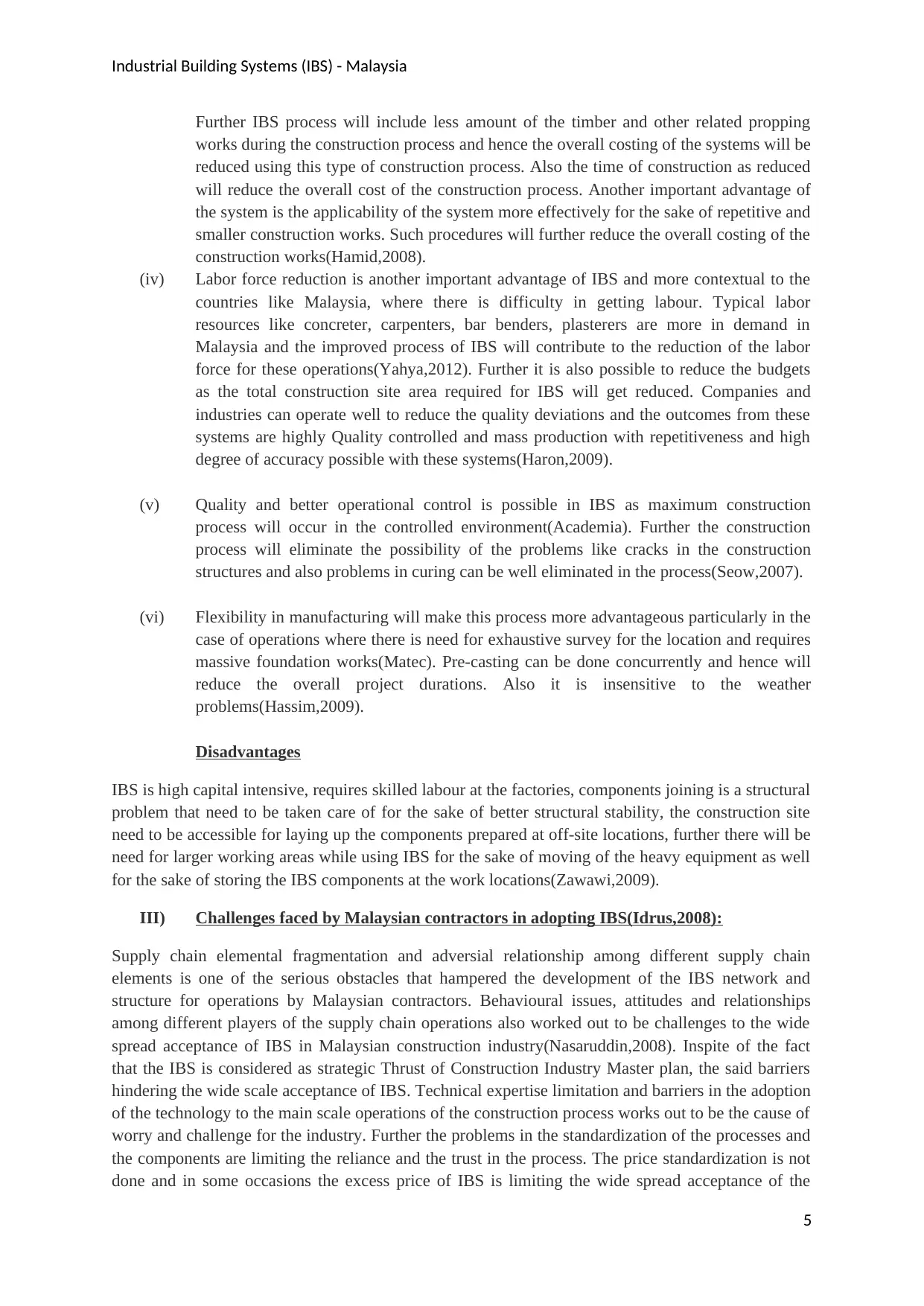
Industrial Building Systems (IBS) - Malaysia
Further IBS process will include less amount of the timber and other related propping
works during the construction process and hence the overall costing of the systems will be
reduced using this type of construction process. Also the time of construction as reduced
will reduce the overall cost of the construction process. Another important advantage of
the system is the applicability of the system more effectively for the sake of repetitive and
smaller construction works. Such procedures will further reduce the overall costing of the
construction works(Hamid,2008).
(iv) Labor force reduction is another important advantage of IBS and more contextual to the
countries like Malaysia, where there is difficulty in getting labour. Typical labor
resources like concreter, carpenters, bar benders, plasterers are more in demand in
Malaysia and the improved process of IBS will contribute to the reduction of the labor
force for these operations(Yahya,2012). Further it is also possible to reduce the budgets
as the total construction site area required for IBS will get reduced. Companies and
industries can operate well to reduce the quality deviations and the outcomes from these
systems are highly Quality controlled and mass production with repetitiveness and high
degree of accuracy possible with these systems(Haron,2009).
(v) Quality and better operational control is possible in IBS as maximum construction
process will occur in the controlled environment(Academia). Further the construction
process will eliminate the possibility of the problems like cracks in the construction
structures and also problems in curing can be well eliminated in the process(Seow,2007).
(vi) Flexibility in manufacturing will make this process more advantageous particularly in the
case of operations where there is need for exhaustive survey for the location and requires
massive foundation works(Matec). Pre-casting can be done concurrently and hence will
reduce the overall project durations. Also it is insensitive to the weather
problems(Hassim,2009).
Disadvantages
IBS is high capital intensive, requires skilled labour at the factories, components joining is a structural
problem that need to be taken care of for the sake of better structural stability, the construction site
need to be accessible for laying up the components prepared at off-site locations, further there will be
need for larger working areas while using IBS for the sake of moving of the heavy equipment as well
for the sake of storing the IBS components at the work locations(Zawawi,2009).
III) Challenges faced by Malaysian contractors in adopting IBS(Idrus,2008):
Supply chain elemental fragmentation and adversial relationship among different supply chain
elements is one of the serious obstacles that hampered the development of the IBS network and
structure for operations by Malaysian contractors. Behavioural issues, attitudes and relationships
among different players of the supply chain operations also worked out to be challenges to the wide
spread acceptance of IBS in Malaysian construction industry(Nasaruddin,2008). Inspite of the fact
that the IBS is considered as strategic Thrust of Construction Industry Master plan, the said barriers
hindering the wide scale acceptance of IBS. Technical expertise limitation and barriers in the adoption
of the technology to the main scale operations of the construction process works out to be the cause of
worry and challenge for the industry. Further the problems in the standardization of the processes and
the components are limiting the reliance and the trust in the process. The price standardization is not
done and in some occasions the excess price of IBS is limiting the wide spread acceptance of the
5
Further IBS process will include less amount of the timber and other related propping
works during the construction process and hence the overall costing of the systems will be
reduced using this type of construction process. Also the time of construction as reduced
will reduce the overall cost of the construction process. Another important advantage of
the system is the applicability of the system more effectively for the sake of repetitive and
smaller construction works. Such procedures will further reduce the overall costing of the
construction works(Hamid,2008).
(iv) Labor force reduction is another important advantage of IBS and more contextual to the
countries like Malaysia, where there is difficulty in getting labour. Typical labor
resources like concreter, carpenters, bar benders, plasterers are more in demand in
Malaysia and the improved process of IBS will contribute to the reduction of the labor
force for these operations(Yahya,2012). Further it is also possible to reduce the budgets
as the total construction site area required for IBS will get reduced. Companies and
industries can operate well to reduce the quality deviations and the outcomes from these
systems are highly Quality controlled and mass production with repetitiveness and high
degree of accuracy possible with these systems(Haron,2009).
(v) Quality and better operational control is possible in IBS as maximum construction
process will occur in the controlled environment(Academia). Further the construction
process will eliminate the possibility of the problems like cracks in the construction
structures and also problems in curing can be well eliminated in the process(Seow,2007).
(vi) Flexibility in manufacturing will make this process more advantageous particularly in the
case of operations where there is need for exhaustive survey for the location and requires
massive foundation works(Matec). Pre-casting can be done concurrently and hence will
reduce the overall project durations. Also it is insensitive to the weather
problems(Hassim,2009).
Disadvantages
IBS is high capital intensive, requires skilled labour at the factories, components joining is a structural
problem that need to be taken care of for the sake of better structural stability, the construction site
need to be accessible for laying up the components prepared at off-site locations, further there will be
need for larger working areas while using IBS for the sake of moving of the heavy equipment as well
for the sake of storing the IBS components at the work locations(Zawawi,2009).
III) Challenges faced by Malaysian contractors in adopting IBS(Idrus,2008):
Supply chain elemental fragmentation and adversial relationship among different supply chain
elements is one of the serious obstacles that hampered the development of the IBS network and
structure for operations by Malaysian contractors. Behavioural issues, attitudes and relationships
among different players of the supply chain operations also worked out to be challenges to the wide
spread acceptance of IBS in Malaysian construction industry(Nasaruddin,2008). Inspite of the fact
that the IBS is considered as strategic Thrust of Construction Industry Master plan, the said barriers
hindering the wide scale acceptance of IBS. Technical expertise limitation and barriers in the adoption
of the technology to the main scale operations of the construction process works out to be the cause of
worry and challenge for the industry. Further the problems in the standardization of the processes and
the components are limiting the reliance and the trust in the process. The price standardization is not
done and in some occasions the excess price of IBS is limiting the wide spread acceptance of the
5
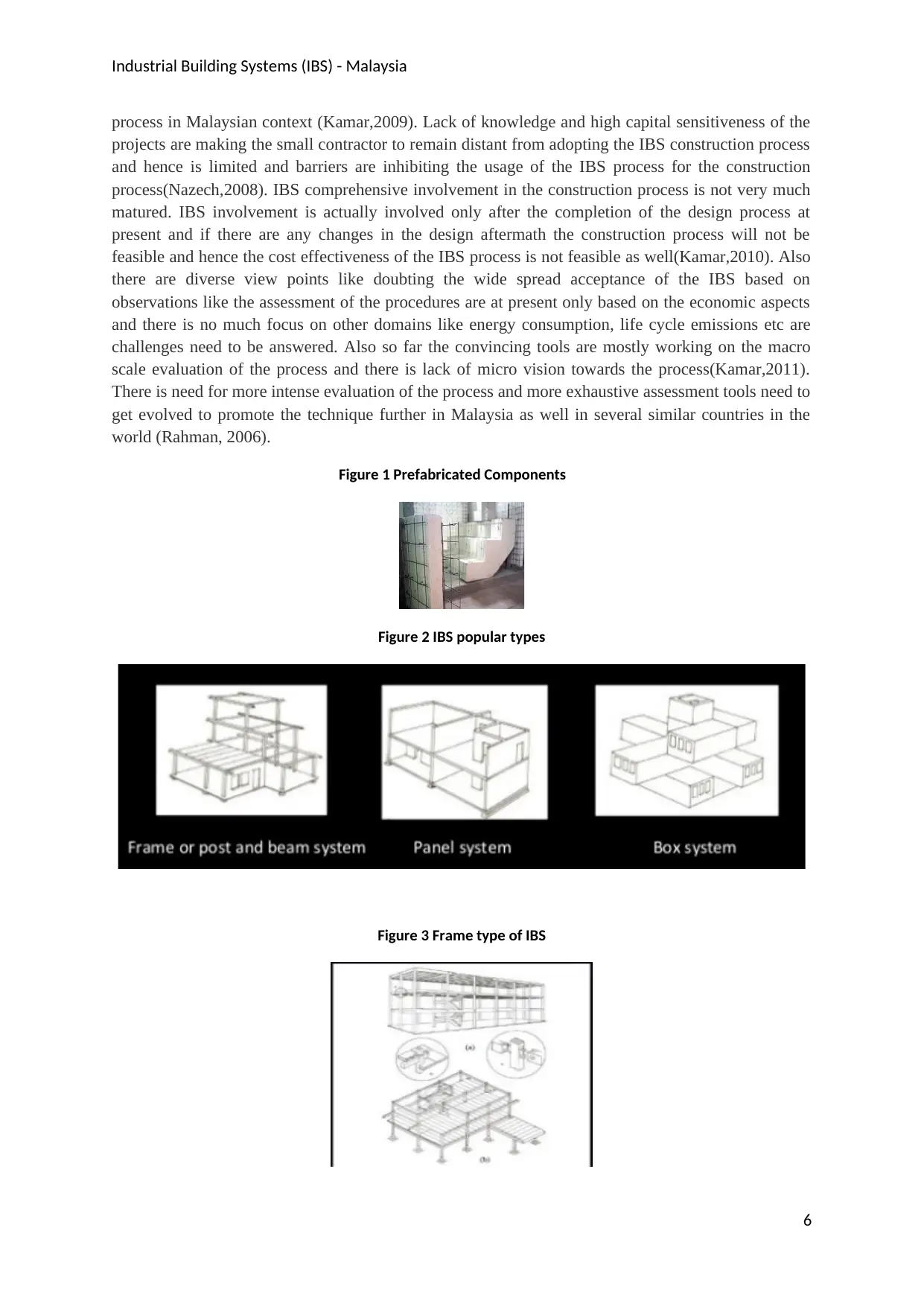
Industrial Building Systems (IBS) - Malaysia
process in Malaysian context (Kamar,2009). Lack of knowledge and high capital sensitiveness of the
projects are making the small contractor to remain distant from adopting the IBS construction process
and hence is limited and barriers are inhibiting the usage of the IBS process for the construction
process(Nazech,2008). IBS comprehensive involvement in the construction process is not very much
matured. IBS involvement is actually involved only after the completion of the design process at
present and if there are any changes in the design aftermath the construction process will not be
feasible and hence the cost effectiveness of the IBS process is not feasible as well(Kamar,2010). Also
there are diverse view points like doubting the wide spread acceptance of the IBS based on
observations like the assessment of the procedures are at present only based on the economic aspects
and there is no much focus on other domains like energy consumption, life cycle emissions etc are
challenges need to be answered. Also so far the convincing tools are mostly working on the macro
scale evaluation of the process and there is lack of micro vision towards the process(Kamar,2011).
There is need for more intense evaluation of the process and more exhaustive assessment tools need to
get evolved to promote the technique further in Malaysia as well in several similar countries in the
world (Rahman, 2006).
Figure 1 Prefabricated Components
Figure 2 IBS popular types
Figure 3 Frame type of IBS
6
process in Malaysian context (Kamar,2009). Lack of knowledge and high capital sensitiveness of the
projects are making the small contractor to remain distant from adopting the IBS construction process
and hence is limited and barriers are inhibiting the usage of the IBS process for the construction
process(Nazech,2008). IBS comprehensive involvement in the construction process is not very much
matured. IBS involvement is actually involved only after the completion of the design process at
present and if there are any changes in the design aftermath the construction process will not be
feasible and hence the cost effectiveness of the IBS process is not feasible as well(Kamar,2010). Also
there are diverse view points like doubting the wide spread acceptance of the IBS based on
observations like the assessment of the procedures are at present only based on the economic aspects
and there is no much focus on other domains like energy consumption, life cycle emissions etc are
challenges need to be answered. Also so far the convincing tools are mostly working on the macro
scale evaluation of the process and there is lack of micro vision towards the process(Kamar,2011).
There is need for more intense evaluation of the process and more exhaustive assessment tools need to
get evolved to promote the technique further in Malaysia as well in several similar countries in the
world (Rahman, 2006).
Figure 1 Prefabricated Components
Figure 2 IBS popular types
Figure 3 Frame type of IBS
6
⊘ This is a preview!⊘
Do you want full access?
Subscribe today to unlock all pages.

Trusted by 1+ million students worldwide

Industrial Building Systems (IBS) - Malaysia
Figure 4 Operational sequence of IBS
Figure 5 Successful IBS projects in Malaysia
7
Figure 4 Operational sequence of IBS
Figure 5 Successful IBS projects in Malaysia
7
Paraphrase This Document
Need a fresh take? Get an instant paraphrase of this document with our AI Paraphraser
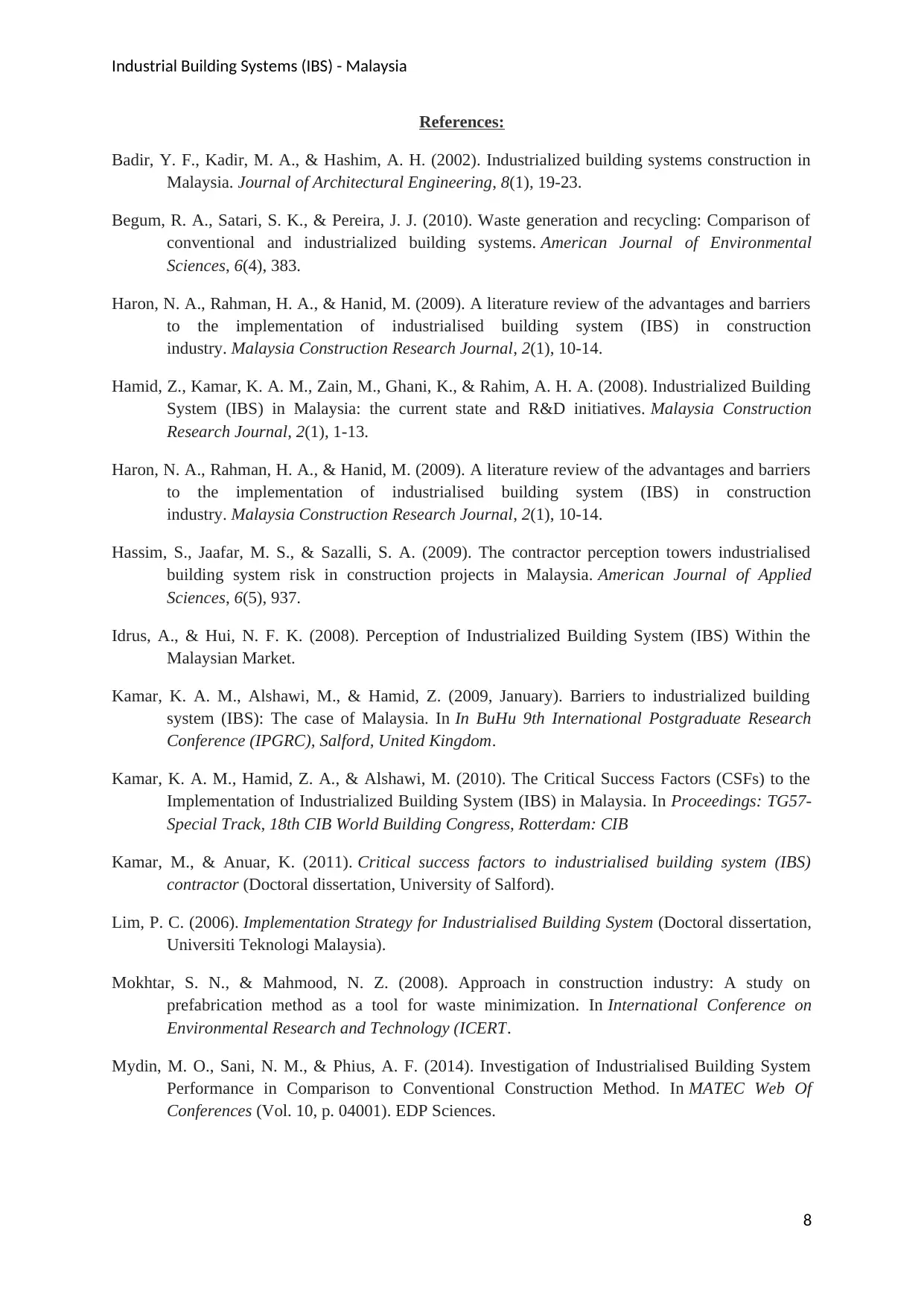
Industrial Building Systems (IBS) - Malaysia
References:
Badir, Y. F., Kadir, M. A., & Hashim, A. H. (2002). Industrialized building systems construction in
Malaysia. Journal of Architectural Engineering, 8(1), 19-23.
Begum, R. A., Satari, S. K., & Pereira, J. J. (2010). Waste generation and recycling: Comparison of
conventional and industrialized building systems. American Journal of Environmental
Sciences, 6(4), 383.
Haron, N. A., Rahman, H. A., & Hanid, M. (2009). A literature review of the advantages and barriers
to the implementation of industrialised building system (IBS) in construction
industry. Malaysia Construction Research Journal, 2(1), 10-14.
Hamid, Z., Kamar, K. A. M., Zain, M., Ghani, K., & Rahim, A. H. A. (2008). Industrialized Building
System (IBS) in Malaysia: the current state and R&D initiatives. Malaysia Construction
Research Journal, 2(1), 1-13.
Haron, N. A., Rahman, H. A., & Hanid, M. (2009). A literature review of the advantages and barriers
to the implementation of industrialised building system (IBS) in construction
industry. Malaysia Construction Research Journal, 2(1), 10-14.
Hassim, S., Jaafar, M. S., & Sazalli, S. A. (2009). The contractor perception towers industrialised
building system risk in construction projects in Malaysia. American Journal of Applied
Sciences, 6(5), 937.
Idrus, A., & Hui, N. F. K. (2008). Perception of Industrialized Building System (IBS) Within the
Malaysian Market.
Kamar, K. A. M., Alshawi, M., & Hamid, Z. (2009, January). Barriers to industrialized building
system (IBS): The case of Malaysia. In In BuHu 9th International Postgraduate Research
Conference (IPGRC), Salford, United Kingdom.
Kamar, K. A. M., Hamid, Z. A., & Alshawi, M. (2010). The Critical Success Factors (CSFs) to the
Implementation of Industrialized Building System (IBS) in Malaysia. In Proceedings: TG57-
Special Track, 18th CIB World Building Congress, Rotterdam: CIB
Kamar, M., & Anuar, K. (2011). Critical success factors to industrialised building system (IBS)
contractor (Doctoral dissertation, University of Salford).
Lim, P. C. (2006). Implementation Strategy for Industrialised Building System (Doctoral dissertation,
Universiti Teknologi Malaysia).
Mokhtar, S. N., & Mahmood, N. Z. (2008). Approach in construction industry: A study on
prefabrication method as a tool for waste minimization. In International Conference on
Environmental Research and Technology (ICERT.
Mydin, M. O., Sani, N. M., & Phius, A. F. (2014). Investigation of Industrialised Building System
Performance in Comparison to Conventional Construction Method. In MATEC Web Of
Conferences (Vol. 10, p. 04001). EDP Sciences.
8
References:
Badir, Y. F., Kadir, M. A., & Hashim, A. H. (2002). Industrialized building systems construction in
Malaysia. Journal of Architectural Engineering, 8(1), 19-23.
Begum, R. A., Satari, S. K., & Pereira, J. J. (2010). Waste generation and recycling: Comparison of
conventional and industrialized building systems. American Journal of Environmental
Sciences, 6(4), 383.
Haron, N. A., Rahman, H. A., & Hanid, M. (2009). A literature review of the advantages and barriers
to the implementation of industrialised building system (IBS) in construction
industry. Malaysia Construction Research Journal, 2(1), 10-14.
Hamid, Z., Kamar, K. A. M., Zain, M., Ghani, K., & Rahim, A. H. A. (2008). Industrialized Building
System (IBS) in Malaysia: the current state and R&D initiatives. Malaysia Construction
Research Journal, 2(1), 1-13.
Haron, N. A., Rahman, H. A., & Hanid, M. (2009). A literature review of the advantages and barriers
to the implementation of industrialised building system (IBS) in construction
industry. Malaysia Construction Research Journal, 2(1), 10-14.
Hassim, S., Jaafar, M. S., & Sazalli, S. A. (2009). The contractor perception towers industrialised
building system risk in construction projects in Malaysia. American Journal of Applied
Sciences, 6(5), 937.
Idrus, A., & Hui, N. F. K. (2008). Perception of Industrialized Building System (IBS) Within the
Malaysian Market.
Kamar, K. A. M., Alshawi, M., & Hamid, Z. (2009, January). Barriers to industrialized building
system (IBS): The case of Malaysia. In In BuHu 9th International Postgraduate Research
Conference (IPGRC), Salford, United Kingdom.
Kamar, K. A. M., Hamid, Z. A., & Alshawi, M. (2010). The Critical Success Factors (CSFs) to the
Implementation of Industrialized Building System (IBS) in Malaysia. In Proceedings: TG57-
Special Track, 18th CIB World Building Congress, Rotterdam: CIB
Kamar, M., & Anuar, K. (2011). Critical success factors to industrialised building system (IBS)
contractor (Doctoral dissertation, University of Salford).
Lim, P. C. (2006). Implementation Strategy for Industrialised Building System (Doctoral dissertation,
Universiti Teknologi Malaysia).
Mokhtar, S. N., & Mahmood, N. Z. (2008). Approach in construction industry: A study on
prefabrication method as a tool for waste minimization. In International Conference on
Environmental Research and Technology (ICERT.
Mydin, M. O., Sani, N. M., & Phius, A. F. (2014). Investigation of Industrialised Building System
Performance in Comparison to Conventional Construction Method. In MATEC Web Of
Conferences (Vol. 10, p. 04001). EDP Sciences.
8
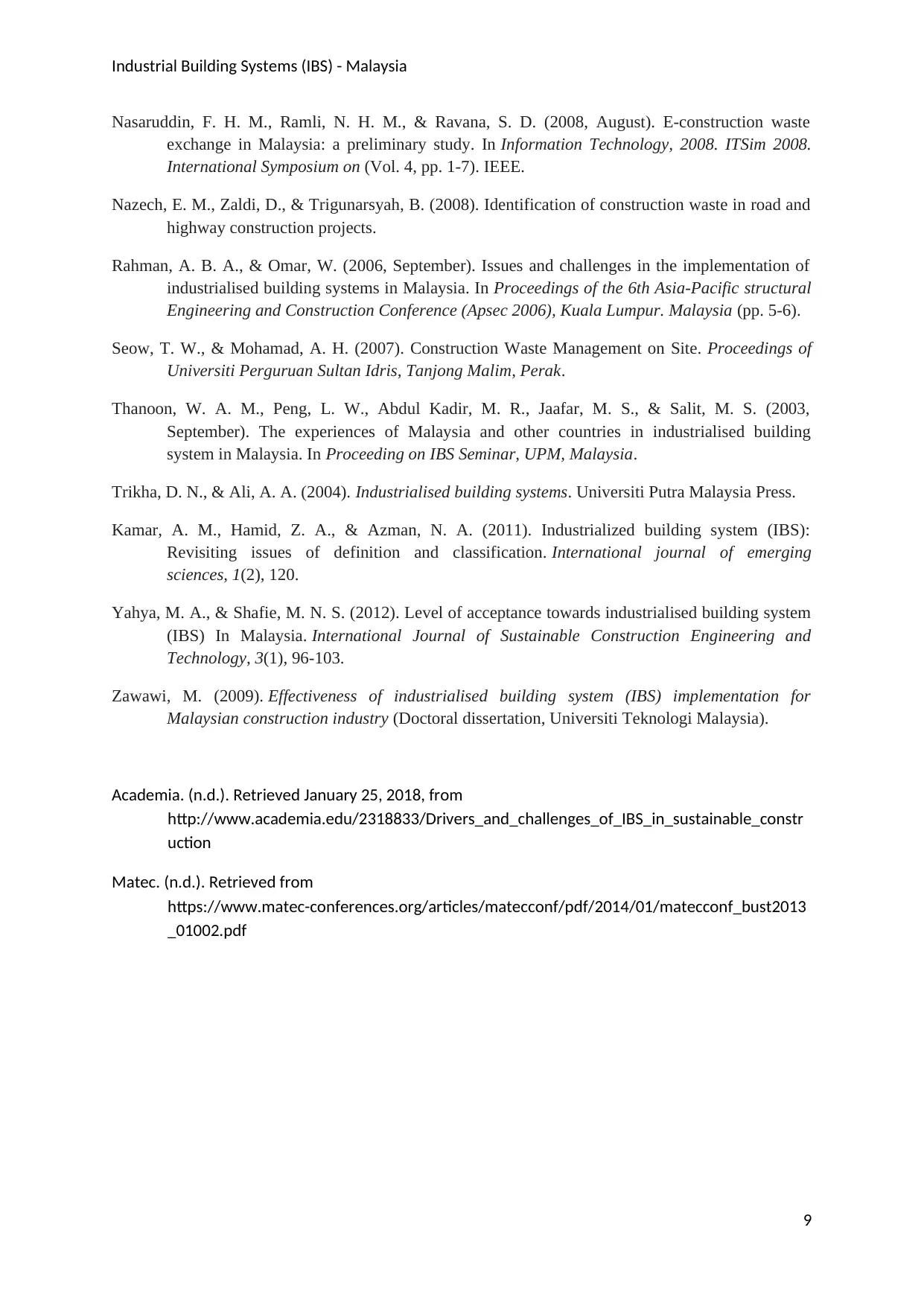
Industrial Building Systems (IBS) - Malaysia
Nasaruddin, F. H. M., Ramli, N. H. M., & Ravana, S. D. (2008, August). E-construction waste
exchange in Malaysia: a preliminary study. In Information Technology, 2008. ITSim 2008.
International Symposium on (Vol. 4, pp. 1-7). IEEE.
Nazech, E. M., Zaldi, D., & Trigunarsyah, B. (2008). Identification of construction waste in road and
highway construction projects.
Rahman, A. B. A., & Omar, W. (2006, September). Issues and challenges in the implementation of
industrialised building systems in Malaysia. In Proceedings of the 6th Asia-Pacific structural
Engineering and Construction Conference (Apsec 2006), Kuala Lumpur. Malaysia (pp. 5-6).
Seow, T. W., & Mohamad, A. H. (2007). Construction Waste Management on Site. Proceedings of
Universiti Perguruan Sultan Idris, Tanjong Malim, Perak.
Thanoon, W. A. M., Peng, L. W., Abdul Kadir, M. R., Jaafar, M. S., & Salit, M. S. (2003,
September). The experiences of Malaysia and other countries in industrialised building
system in Malaysia. In Proceeding on IBS Seminar, UPM, Malaysia.
Trikha, D. N., & Ali, A. A. (2004). Industrialised building systems. Universiti Putra Malaysia Press.
Kamar, A. M., Hamid, Z. A., & Azman, N. A. (2011). Industrialized building system (IBS):
Revisiting issues of definition and classification. International journal of emerging
sciences, 1(2), 120.
Yahya, M. A., & Shafie, M. N. S. (2012). Level of acceptance towards industrialised building system
(IBS) In Malaysia. International Journal of Sustainable Construction Engineering and
Technology, 3(1), 96-103.
Zawawi, M. (2009). Effectiveness of industrialised building system (IBS) implementation for
Malaysian construction industry (Doctoral dissertation, Universiti Teknologi Malaysia).
Academia. (n.d.). Retrieved January 25, 2018, from
http://www.academia.edu/2318833/Drivers_and_challenges_of_IBS_in_sustainable_constr
uction
Matec. (n.d.). Retrieved from
https://www.matec-conferences.org/articles/matecconf/pdf/2014/01/matecconf_bust2013
_01002.pdf
9
Nasaruddin, F. H. M., Ramli, N. H. M., & Ravana, S. D. (2008, August). E-construction waste
exchange in Malaysia: a preliminary study. In Information Technology, 2008. ITSim 2008.
International Symposium on (Vol. 4, pp. 1-7). IEEE.
Nazech, E. M., Zaldi, D., & Trigunarsyah, B. (2008). Identification of construction waste in road and
highway construction projects.
Rahman, A. B. A., & Omar, W. (2006, September). Issues and challenges in the implementation of
industrialised building systems in Malaysia. In Proceedings of the 6th Asia-Pacific structural
Engineering and Construction Conference (Apsec 2006), Kuala Lumpur. Malaysia (pp. 5-6).
Seow, T. W., & Mohamad, A. H. (2007). Construction Waste Management on Site. Proceedings of
Universiti Perguruan Sultan Idris, Tanjong Malim, Perak.
Thanoon, W. A. M., Peng, L. W., Abdul Kadir, M. R., Jaafar, M. S., & Salit, M. S. (2003,
September). The experiences of Malaysia and other countries in industrialised building
system in Malaysia. In Proceeding on IBS Seminar, UPM, Malaysia.
Trikha, D. N., & Ali, A. A. (2004). Industrialised building systems. Universiti Putra Malaysia Press.
Kamar, A. M., Hamid, Z. A., & Azman, N. A. (2011). Industrialized building system (IBS):
Revisiting issues of definition and classification. International journal of emerging
sciences, 1(2), 120.
Yahya, M. A., & Shafie, M. N. S. (2012). Level of acceptance towards industrialised building system
(IBS) In Malaysia. International Journal of Sustainable Construction Engineering and
Technology, 3(1), 96-103.
Zawawi, M. (2009). Effectiveness of industrialised building system (IBS) implementation for
Malaysian construction industry (Doctoral dissertation, Universiti Teknologi Malaysia).
Academia. (n.d.). Retrieved January 25, 2018, from
http://www.academia.edu/2318833/Drivers_and_challenges_of_IBS_in_sustainable_constr
uction
Matec. (n.d.). Retrieved from
https://www.matec-conferences.org/articles/matecconf/pdf/2014/01/matecconf_bust2013
_01002.pdf
9
⊘ This is a preview!⊘
Do you want full access?
Subscribe today to unlock all pages.

Trusted by 1+ million students worldwide
1 out of 9
Related Documents
Your All-in-One AI-Powered Toolkit for Academic Success.
+13062052269
info@desklib.com
Available 24*7 on WhatsApp / Email
![[object Object]](/_next/static/media/star-bottom.7253800d.svg)
Unlock your academic potential
Copyright © 2020–2025 A2Z Services. All Rights Reserved. Developed and managed by ZUCOL.





